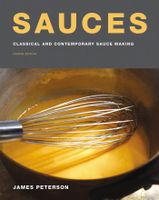Advertisement
Preparation info
- yield:
4 to 6
servings - Difficulty
Easy
Appears in
Published 1991
Traditional recipes for coq au vin finish the sauce with the rooster’s blood, which is still a good idea if starting with a live bird (see “Blood”). Coq au vin is usually thought of as Burgundian, and some cooks underline this fact by using a good marc de Bourgogne to deglaze the pan after browning and again to finish the braising liquid. Another approach is to give the dish local character by using the appropriate wine and herbs, and finishing with the a


